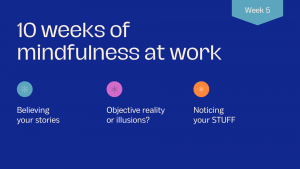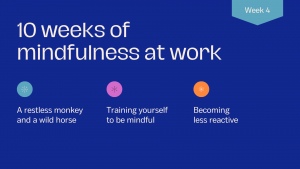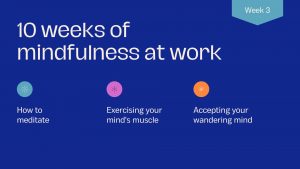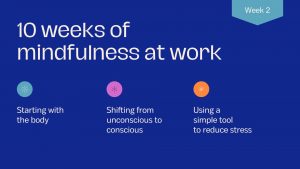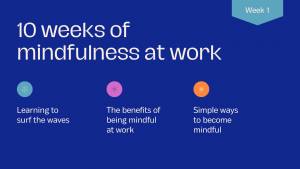10 Weeks of Mindfulness at Work
Welcome to week five of “10 Weeks of Mindfulness at Work” where you’ll discover simple tips and techniques to enrich your day with mindfulness. I hope you find inspiration from this series!
– Believing Your Stories
Have you ever told yourself a story that wasn’t true? I sure have. Early in my speaking career, I was thrilled to be the monthly speaker at a meeting of the National Association of Professional Saleswomen. Part way into the presentation, I introduced an exercise where each person blew up a balloon and then stomped on it.
As the air filled with the sounds of more than 100 bursting balloons – and the sounds of laughter — one woman scowled and shook her head in disapproval. My attention zeroed in on her as the voice in my head said, “She hates your presentation.” And of course, I believed that voice. I felt completely deflated.
– Objective Reality or Illusions?
Afterward, when everyone had filed out of the room, she approached me. I’ll never forget her words, as she said, “I loved your message, but the noise of the balloons breaking was so loud, it reminded me of my difficult childhood, growing up in a violent neighborhood.” Wow. Her reaction had nothing to do with me; yet, I created a story in my mind where it had everything to do with me.
Now, we all create stories in our minds; it’s the way we make sense of the world. Yet, often people fill in gaps of missing details with stories that may seem like objective reality, when they’re actually just illusions.
For instance, if your manager calls you into a special meeting, does your mind spin with stories beforehand? Perhaps you’re worried about being reprimanded, demoted or even being fired.
– Noticing Your STUFF
Mindfulness helps you notice your STUFF — The Stories, Thoughts, Urges, Frustrations and Feelings that cycle in the mind. This awareness enables you to realize, “I’m telling myself a story which may or may not be true.”
Noticing your stories can be very freeing. Rather than getting lost in the emotion of an outcome which is unknown at this point, you are living in the immediacy of the present moment. As the magnet on my refrigerator wisely states, “Don’t believe everything you think.”
Reflection: Have you ever reacted to a story that turned out not to be true?
WEEK FIVE PRACTICE SUGGESTION: Notice the stories you tell yourself. Are they true? Are they useful?
**Celebrating a 10th Anniversary
Be on the lookout for a 99¢ Kindle promotion in July to celebrate the 10th anniversary of “Meditation Illuminated: Simple Ways to Manage Your Busy Mind,” a step-by-step book for beginning meditators. Available in Kindle, paperback and audiobook.
